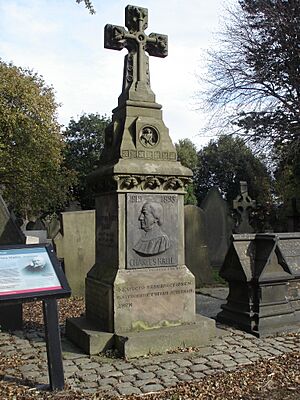Charles Hallé facts for kids
Sir Charles Hallé (born Karl Halle; 11 April 1819 – 25 October 1895) was a talented Anglo-German pianist and conductor. He is most famous for starting The Hallé orchestra in 1858.
Contents
Early Life and Musical Journey
Charles Hallé was born Karl Halle on 11 April 1819 in Hagen, which was then in Westphalia, Germany. When he moved to England, he changed his name to Charles Hallé.
First Steps in Music
His first music lessons came from his father, who was an organist. Charles showed amazing talent for playing the piano from a very young age. He even played a small piano piece in public when he was only four years old! As a young boy, he also played percussion in an orchestra. In 1828, he performed in a concert in Cassel, where a famous musician named Spohr noticed his skills.
Studying and Moving to Paris
In 1835, Charles studied with Christian Heinrich Rinck in Darmstadt, Germany. Just a year later, in 1836, he moved to Paris, France. He lived there for twelve years and met many famous musicians like Luigi Cherubini, Frédéric Chopin, and Franz Liszt. He also became friends with important writers such as Alfred de Musset and George Sand.
While in Paris, Charles taught music and started a series of successful chamber concerts. These were small concerts featuring a few musicians, like a trio with Jean-Delphin Alard and Auguste Franchomme. One of his students was the composer Jane Roeckel.
Moving to London
Charles had just finished one of his concert series when a revolution happened in Paris in 1848. This made him move to London, England, with his first wife and two children.
Building a Musical Legacy
In England, Charles Hallé continued to perform as a pianist and conducted orchestras. He was the first pianist in England to play all of Beethoven's piano sonatas. These are very important and challenging pieces of music.
Concerts and Inventions
From 1850, Charles Hallé started giving piano recitals, first at his own home and later at St James's Hall in Piccadilly. These concerts were a big part of London's music scene. Thanks to him, many people in England learned about Beethoven's piano sonatas.
Charles also invented a special mechanical page-turner for pianists. This device held the music pages, and the player could turn each page using a foot pedal. People were amazed to see the pages turn by themselves during his concerts!
He often performed at the Musical Union, started by John Ella, and at the Popular Concerts from their very beginning.
Founding The Hallé Orchestra
In 1853, Charles moved to Manchester to lead the Gentleman's Concerts, which had its own orchestra. In May 1857, he was asked to put together a small orchestra to play for Prince Albert. This was for the opening of the Art Treasures of Great Britain, a huge exhibition in Manchester.
Charles accepted the challenge and was very happy with how the orchestra played. He decided to keep the group together. This led to the creation of the famous Hallé Orchestra. The orchestra gave its first official concert on 30 January 1858.
The orchestra's first home was the Free Trade Hall. By 1861, the orchestra faced money problems, performing only two concerts that year. However, it managed to survive and has continued to thrive under many great conductors.
Later Life and Family
In 1888, Charles Hallé married for a second time. His new wife was the famous violinist Wilma Neruda. Her family was well-known for their musical talent.
That same year, Charles was made a knight, which means he was given the title "Sir." In 1890 and 1891, he toured with his wife in Australia and other places. In 1891, he also helped start the Royal Manchester College of Music. He became its head and the main professor for piano.
Sir Charles Hallé passed away in Manchester on 25 October 1895. He was buried in Weaste Cemetery, Salford. Lady Hallé, who was one of the top solo violinists of her time, often performed with her husband until his death.
His Children
Charles Hallé was married twice. His first wife, Desirée Smith de Rilieu, died in 1866. They married on 11 November 1841. His second marriage was to Madame Wilma Neruda on 26 July 1888.
His son from his first marriage, Charles Edward Hallé, became a painter and managed art galleries. His daughter, Elinor Hallé CBE, was a talented sculptor and inventor.



